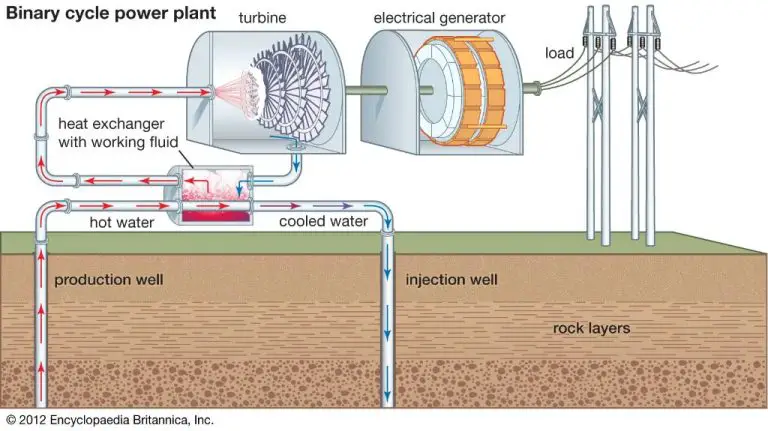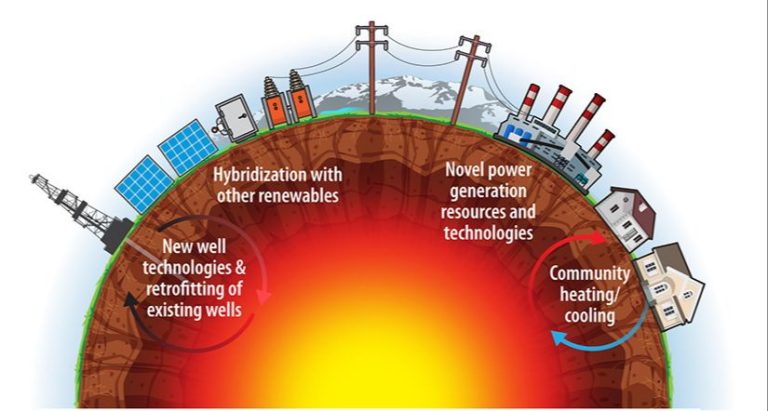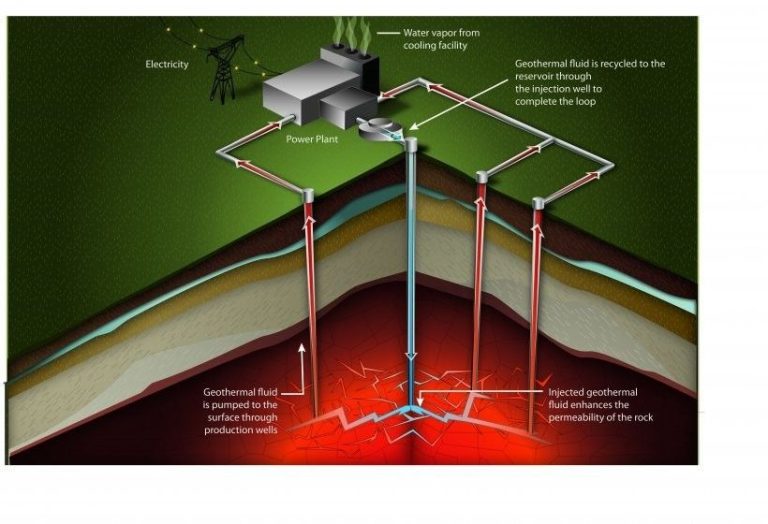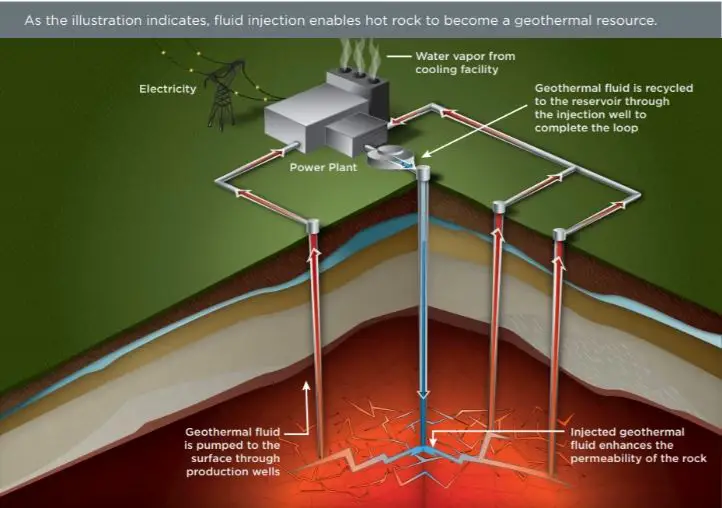The Environmental Impact Of Geothermal Energy: Sustainability Analysis
Geothermal energy is thermal energy generated and stored in the Earth. It originates from the original formation of the planet, from radioactive decay of minerals, and from solar energy absorbed at the surface. The geothermal gradient, which is the difference in temperature between the core of the planet and its surface, drives a continuous conduction of thermal energy in the form of heat from the core to the surface.
There are three main types of geothermal energy sources: hydrothermal resources which contain hot water and steam, geopressured resources which contain hot water and methane, and hot dry rock resources which require fluid to be injected before energy can be extracted. Most geothermal power plants tap into hydrothermal resources located near tectonic plate boundaries, volcanic hotspots, and areas with abnormally high heat flow.
Humans have utilized geothermal energy for bathing, cooking, and heating since ancient times. The first industrial extraction of geothermal resources began in 1904 in Larderello, Italy. In the 20th century, countries like the US, Philippines, Indonesia, Mexico, Iceland, New Zealand, and El Salvador began using geothermal energy to generate electricity. Today, geothermal energy contributes about 1% of the world’s total electricity generation capacity.
Geothermal Power Plant Operations
There are three main types of geothermal power plants: dry steam, flash, and binary. Each type utilizes different characteristics of geothermal resources to generate electricity:
Dry Steam Power Plants
Dry steam power plants are the simplest and oldest form of geothermal power generation. They directly use the steam from geothermal reservoirs to turn turbine generators. The steam rises from the reservoir through production wells and is piped directly into the power plant. After passing through the turbine, the cooled steam is returned to the reservoir via injection wells.
Flash Power Plants
Flash power plants are the most common geothermal power plant today. They use water at temperatures greater than 360°F that is flashed into steam in a low-pressure tank. The steam then drives a turbine generator. Any leftover water and condensed steam are re-injected into the reservoir.
Binary Cycle Power Plants
Binary cycle power plants operate using hot water from moderate-temperature reservoirs (270–360°F). The hot water is passed through a heat exchanger where it heats and vaporizes a separate organic fluid with a much lower boiling point. This causes the organic fluid to flash to vapor, which then drives the turbine. The water and condensed fluid are then re-injected into the reservoir.
Land Use and Wildlife Impacts
Geothermal power plants require less land area than most other energy sources. Solar farms can require over 100 times more land area than a geothermal plant for the same energy output. Fossil fuel plants also require large areas for mining and drilling operations. In comparison, geothermal plants have a relatively small footprint.
However, geothermal development may still impact natural habitats and wildlife. Construction of the power plant and its supporting infrastructure disturbs the land. Pipelines must be laid, access roads built, and facilities constructed. This can fragment or degrade sensitive ecosystems.
There are also risks associated with geothermal fluids. The high temperature liquids can contain hazardous elements and compounds if released into the environment. Proper containment and injection procedures are critical to avoid contaminating habitats. Careful siting of geothermal plants is also important to minimize disruption of natural areas.
With proper impact assessments and mitigation strategies, geothermal energy can be implemented with limited effects on wildlife and habitats. Noise and light pollution should be minimized, native vegetation maintained where possible, and habitats restored after construction. If sited conscientiously, geothermal plants present fewer land use conflicts than many other energy technologies.
Air and Climate Impacts
Geothermal power can provide climate benefits compared to fossil fuel power plants. Geothermal plants emit little to no greenhouse gases as they do not burn fossil fuels. The geothermal steam and hot water used to generate electricity emits mainly steam and very minor levels of carbon dioxide and methane. According to research, geothermal plants produce an average of 4 grams of CO2 per kilowatt-hour compared to fossil fuels which produce around 1,000 grams per kilowatt-hour.
This means geothermal can substantially reduce greenhouse gas emissions and help mitigate climate change if deployed widely. The EPA estimates geothermal power can reduce CO2 emissions by over 80% compared to a coal plant. Some advanced geothermal systems are even working on injecting the gases back underground so emissions are further minimized.
In addition to greenhouse gases, geothermal plants emit far lower levels of other air pollutants like particulate matter, sulfur dioxide, and nitrogen oxides. This leads to better local air quality and public health outcomes. Overall, geothermal provides a clean, emissions-free power source compared to fossil fuel alternatives.
Water Usage
Compared to other sources of electricity, geothermal plants generally use less water. Fossil fuel plants, like coal, natural gas and nuclear, require water for cooling and condensing steam. Solar photovoltaic and wind turbines use very little water. However, geothermal plants do require water during drilling, development and operation.
During drilling and development, water is used to suppress well formations and as a primary drilling fluid. The amounts vary based on the depth and number of wells drilled. Flash and dry steam plants use between 20-200 gallons per megawatt hour (gal/MWh). Binary geothermal plants use more, around 400-600 gal/MWh since the secondary fluid loop requires cooling.
Geothermal plants produce wastewater from noncondensible gases, spills, leaks and maintenance activities. The wastewater contains heavy metals, like mercury, arsenic and boron. Most plants inject the wastewater deep underground to avoid surface contamination. Evaporation ponds are also used but pose a risk to wildlife. New technologies like zero liquid discharge systems are being developed to minimize wastewater production.
Induced Seismicity
Geothermal power generation involves injecting fluid into deep wells drilled into hot rock formations. This injection of fluid can increase pressure on fault lines, potentially triggering small earthquakes. The level of seismic risk depends on factors like local geology, injection rate/volume, and pre-existing stresses in rock formations.
While induced seismic events are usually low magnitude and cause little to no damage, larger earthquakes above magnitude 4.0 on the Richter scale have been linked to some enhanced geothermal systems. This has raised public concerns in areas where fracking and geothermal projects are located near populated areas.
To monitor and mitigate seismicity risks, project operators can conduct seismic hazard studies, adjust injection parameters, limit injection volumes, and install seismic monitoring equipment. New techniques like traffic light warning systems can also help – this involves scaling back operations if seismic activity exceeds certain thresholds. Avoiding faults and fractures when drilling injection wells also helps reduce seismic impacts.
Overall, induced seismicity remains a key environmental concern for geothermal. Careful siting, testing, and monitoring can reduce risks, but more research is needed to better understand the relationships between geothermal operations and earthquake activity.
Waste Production
The operation of geothermal power plants produces several types of wastes that need to be properly managed. The main categories are solid wastes and gaseous emissions.
Solid wastes include used geothermal fluids, sludges, and solid particles that are filtered out of the geothermal fluid. These wastes contain elevated levels of minerals, metals, and salts, as well as potential pollutants like arsenic, mercury, and boron. Proper handling of these solids usually involves settling ponds to allow the solids to settle out of the geothermal fluids. The remaining liquid can then be reused or injected back into the geothermal reservoir. The solid wastes are disposed of according to regulations, often involving lined landfills designed for hazardous industrial wastes.
Gaseous wastes produced by geothermal plants include carbon dioxide (CO2), hydrogen sulfide (H2S), ammonia (NH3), methane (CH4), and trace gases like boron, arsenic, and mercury. The quantities and composition of these gases vary depending on the geothermal resource. Methods for managing gaseous emissions focus on scrubbing and filtering techniques to remove harmful pollutants before release into the atmosphere. Scrubbers use water or reagents to absorb problematic gases. Filters made of materials like activated carbon can also selectively capture certain gases. Emissions control systems allow geothermal facilities to limit impacts to air quality.
Sustainability Analysis
When analyzing the sustainability and environmental impact of geothermal energy, it is important to take a lifecycle approach and compare it to other energy sources. In terms of carbon emissions, geothermal power has one of the lowest carbon footprints over its lifetime. Studies have estimated the lifecycle greenhouse gas emissions of geothermal to be just 38 gCO2/kWh. This is considerably lower than natural gas (400-500 gCO2/kWh), oil (650 gCO2/kWh), and coal (800-1000 gCO2/kWh). Geothermal emits 90% less greenhouse gases than a natural gas plant and 95% less than a coal plant.
Part of the reason the carbon footprint is so low is because geothermal plants do not burn fuel to generate electricity. The steam or hot water used to turn the turbines is produced from naturally existing heat within the earth’s crust. Geothermal plants also have a high capacity factor of around 90-95%, meaning they can generate consistent baseload power year-round. The lifespan of a geothermal power plant is estimated to be around 20-30 years. When factoring in the emissions over the entire lifetime, geothermal has clear sustainability advantages over fossil fuels.
In addition to greenhouse gas emissions, geothermal development has relatively low impacts on land use and water consumption compared to other energy sources. The physical footprint of a geothermal plant itself is small, usually around 1-8 acres. Water consumption is about half that of nuclear and natural gas power plants. Overall, geothermal energy has a number of sustainability benefits over conventional and renewable energy sources.
Future Advancements
The geothermal energy industry is actively pursuing innovations to improve efficiency and reduce environmental impacts. Key areas of research and development include:
Advanced drilling techniques – New drilling methods like spallation drilling can access geothermal resources deeper underground with less noise and surface disturbance. This expands potential for geothermal energy in more locations.
Enhanced geothermal systems (EGS) – EGS injects fluid into hot, dry underground rock formations to create artificial geothermal reservoirs, allowing geothermal power generation in areas without natural hydrothermal resources.
Hybrid power plants – Combining geothermal with solar photovoltaic or biomass power generation can boost overall plant efficiency.
Binary cycle plants – Using low-boiling point fluids in a closed loop binary cycle can boost the efficiency of geothermal electricity generation.
Mineral recovery – New techniques are being developed to extract lithium, manganese, zinc and other valuable minerals from geothermal brines as a productive use of waste fluids.
Global geothermal power capacity is projected to grow from around 15 gigawatts today to almost 60 gigawatts by 2030. With further technological improvements, the geothermal energy industry can continue expanding sustainably as a renewable baseload power source.
Conclusion
When we look at the environmental impacts of geothermal energy as a whole, there are both advantages and disadvantages to consider. On the positive side, geothermal power plants produce minimal air emissions compared to fossil fuel plants. The plants themselves take up a relatively small land footprint, and closed-loop systems reuse the geothermal fluid, reducing water consumption. Geothermal energy also provides reliable baseload power without relying on variable sources like wind and solar.
However, geothermal plants can impact surrounding habitat and wildlife if not properly managed. The drilling and fracturing required to create geothermal wells does carry risks of induced seismicity. And while minimal, there are still some emissions and wastes that require disposal. Overall though, geothermal energy is considered one of the cleanest and most sustainable baseload renewable energy sources available.
Looking ahead, geothermal will play an important role in the global energy transition away from fossil fuels. With the ability to provide always-on power, geothermal can complement the intermittent generation from wind and solar. Further innovation and research into advanced geothermal systems could also dramatically expand potential capacity. While not without some environmental considerations, geothermal energy will be an essential part of building a clean, renewable 21st century grid.







